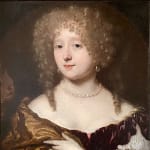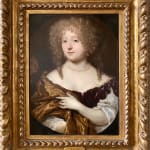16th and 17th century paintings
Nicolaes Maes (1634-1693)
Provenance
Private collection, BelgiumLiterature
L. Krempel, Studien Zu Den Datierten Gemalden Des Nicolaes Maes, Petersburg, 2000A. V. Suchtelen, Nicolaes Maes - Innovation and Versatility, from Dutch Master of the Golden Age, in association with the National Gallery , London and the Mauritshuis, The Hague, Yale University Press, 2020
Portrait of a lady richly dressed in a purple silk gown with white sleeves, a gold coloured cloak draped across one shoulder, her blonde curls worn up with ringlets falling down either side, wearing pearl drop earrings and a pearl necklace. Set into a feigned oval.
Although the identity of the sitter is unknown, she is likely to have been from one of the wealthy merchant families in Amsterdam (known as 'burghers') who were keen to show their new found wealth and status through commissioning fashionable portraits of their family members. This portrait dates from the late 1660's when Maes was at the height of his career, when having a portrait painted by him was seen as most prestigious.
Nicolaes Maes was one of Rembrandt's most talented pupils. As a boy of about thirteen or fourteen, he left his parents' home in Dordrecht to serve his apprenticeship with the master in Amsterdam. He spent four or five years in Rembrandt's workshop, returning to Dordrecht in 1653 as a fully-fledged artist. Maes started out as a ‘history’ painter, following in Rembrandt's footsteps, but he soon switched the focus of his activities to genre painting of intimate and detailed domestic scenes. In a short period between 1654 and 1658 he was one of the most innovative painters in this field. His skill at representing an interior as a suite of rooms rather than a three-wall, one-room enclosure, and the true-to life details and intimate nature of his paintings had great impact on the Delft painters Johannes Vermeer and Pieter de Hooch.
Arnold Houbraken's 1721 biography described the transformation: Maes "learned the art of painting from Rembrandt but lost that way of painting early, particularly when he took up portraiture and discovered that young ladies preferred white to brown."
Maes painted his first portraits in 1655, and shortly before 1660 he stopped painting genre works and other paintings altogether, concentrating solely on portraiture, eventually developing a colourful and elegant style that appealed to a broad circle of wealthy clients in Dordrecht, Amsterdam and beyond.
.





